I haven’t forgotten about you, left to wander the corridors of the Roman Arena, looking nervously over your shoulder for stray bulls. Mais bien sûr que non! Built in 70-80 AD, this stone couronne, with its two levels of 60 arches each, was drawn to scale as half the size of Rome’s Colosseum and became the epicenter of popular entertainment. Here, gladiators pulverized their opponents, the throngs sucked down oysters, servants pulled elaborate sails over the top to provide shade and incense wafted through the air to cover the scent of blood. When violence surrounded the exterior of Arles in the Middle Ages, the Arena was transformed into a fortress that contained over two hundred houses and two churches. It is hard to imagine, isn’t it? The facade has been scrubbed clean, in sections entirely replaced as part of a lengthy renovation. I preferred it as it used to be but am content in the knowledge that it now will stand for centuries to come.
Directly behind us are the remains of the Amphitheatre, one of the largest in Roman Gaul. Of the hundred columns believed to have comprised the proscenium only two remain. Pink and black marble slabs dust the orchestra. A third of the seating–that which wasn’t carted off to build the surrounding houses–rises up to the sky. The Venus d’Arles has long since been hauled off to the Louvre and chunks of broken capitals creep towards the stage as if seeking the limelight once more. But the space is still very much alive and I love that it is used for everything from local dance school presentations to the dramatic evenings during the Rencontres Photography Festival. I will be swaying in the aisles to a crooning Bryan Ferry next month!
Down the Rue du Cloître, past mansions with hidden gardens to the Place de la Republique, our main square, with the town hall (and it’s Mansart-designed ceiling) holding court over what was previously the Place Royale. The obelisk was originally a marker in the Roman circus (think chariot races, not dancing monkeys) that was topped with a golden sun during the time of Louis XIV, then a rooster during the French Revolution and an Imperial eagle for Napoleon. I have been told that the tip of it was missing for years and was discovered in a nearby garden where it was being used as a bench but that could be just gossip. Folks in the South are not beyond telling tall tales. My personal favorite is the one where a Van Gogh painting was found in the back of a hen house. It was being used to patch up a hole in the wall.
More on all that lines the square another time. Or if you are just too curious, here is a post on the magnificent cloister of Saint-Trophime: Hometown beauty. As lunch is fast approaching, I need to pop into Soulier for a baguette. Don’t worry about Ben, he has been trained to sit out front (no doggies in the boulangerie especially not slobbering Golden Retrievers) and if he has been good, will get the tip of the bread.
Next, we’ll just turn off of the Rue de la Republique towards the intersection of the Rue Balze and the Rue Frédéric Mistral for it is one of my favorite spots in Arles. From the distinctive hôtel particulier on one side with its wrought iron balcony (I want to live there someday!) to the building en face whose corner edge was shorn off by years of passing carriage wheels yet is graced with a faceless angel. The sky opens here just so and the contrast of the blue against the cream stone never ceases to take my breath away. It is the condensed form of Arles at its finest.
Not so the end of the block, which has been tagged with layers upon layers of graffiti. The old and the new blending into oblivion. Well, that is Arles too. Both wanting to be remembered and forgotten, simultaneously. And finally with Ben tugging at the leash, in through the front doors and past the corkscrew winding stair, cross the courtyard and into the apartment. One that will not be ours for much longer as the first person to visit it said, “I’ll take it.” Of course she did! No matter where we live, we will always have our interesting town to discover, for small as it is, on no two days does it look the same. Ben and I roam these streets willingly. As I mentioned previously, this was just one of the paths that we often take. More soon…

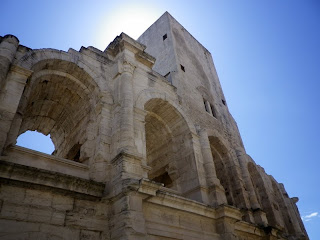
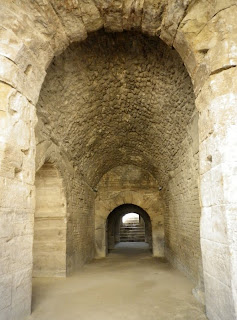
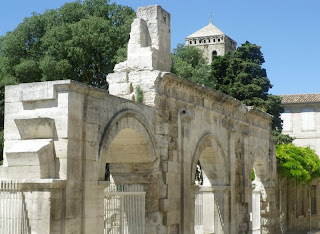
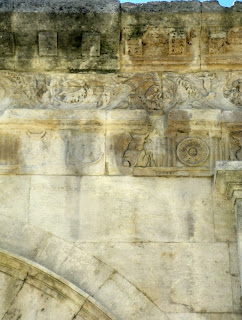
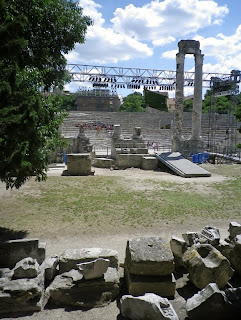
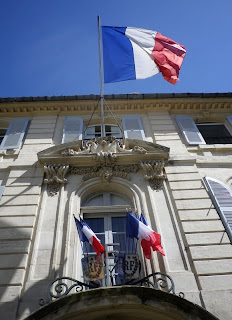
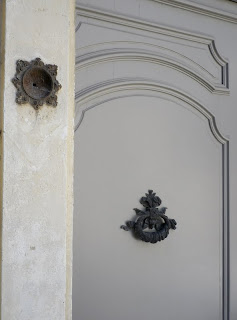
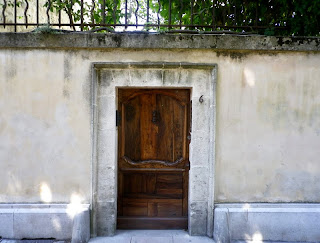

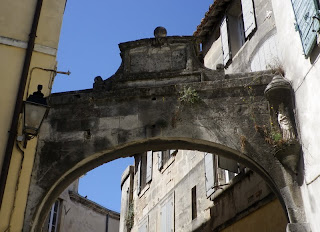
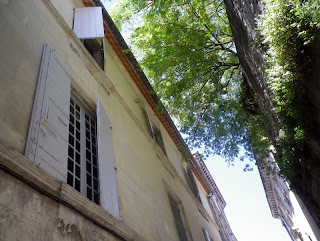


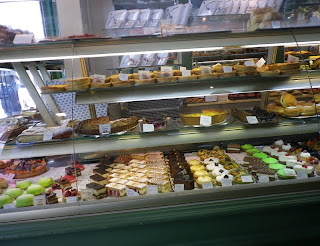


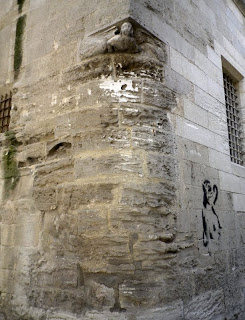
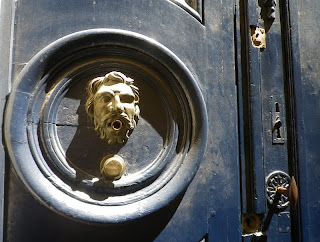
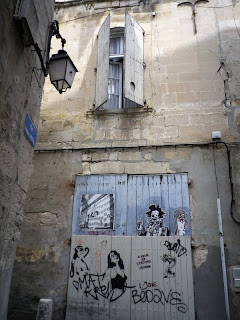

Stacey, whose dog doesn't? 😉 Thank you for the compliment too.
Virginia, I know, I am also fascinated by the doors, especially as there are TWO faces, both with, yes, pipes in their mouths. But why on a front door? It is a house that I love that is sadly, closed up much of the year but if I ever get a chance to ask about it, I will.
Oh Sister, I think you are just a weee bit biased, but thank you! Love you!
I really don't think I knew you could see shows in the amphitheatre! That must be amazing! Dancing monkeys…hee hee. Also, methinks my sister is not just an amazing writer but an amazing photographer!! Am I alone here? Anyone??
Intrigued by the face on the door detail. Is it a pipe in his mouth, for water, or the old base of a handle or what is it?
What a wonderful tour – thank you so much. My dog also appreciates the heels of the baguettes. My favorite line(s) is "The old and the new blending into oblivion. Well, that is Arles too. Both wanting to be remembered and forgotten, simultaneously." Sums it up perfectly!!
Dear Jane and Lance, thank you so much for your kind words, as always. And it is true, any performance in either venue truly is extra special. The memories in those stones…
Hope this finds you both well!
Hello Heather:
So much of interest, so many side streets to explore, we are not surprised that you never tire of 'beating the bounds' of Arles. And, nor would we.
We can well imagine the Roman remains making the most magical of settings for all manner of performances and exhibitions. Just to be amongst those venerable stones would create an atmosphere which so sadly eludes all manner of newer auditoria.
And, how enticing that spiral staircase is leading to the apartment. No wonder 'she' said YES!!